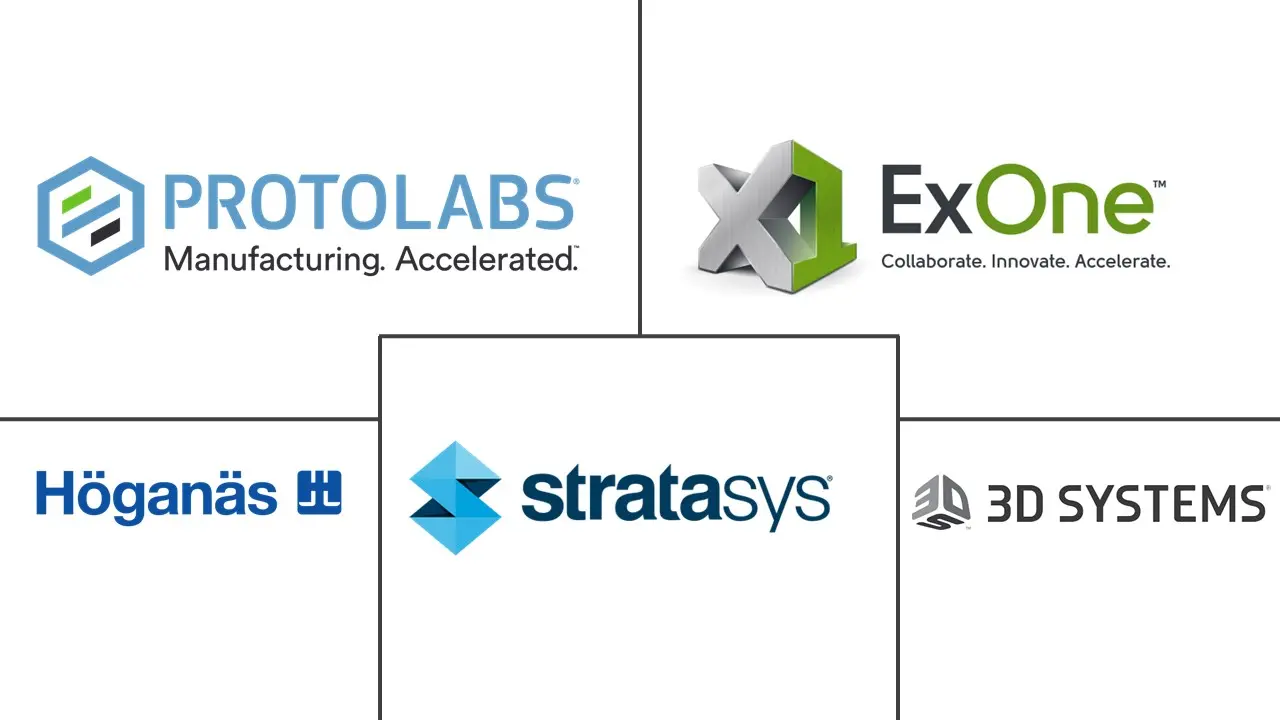Flexible Filament 3D Printing Material Market Size and Share
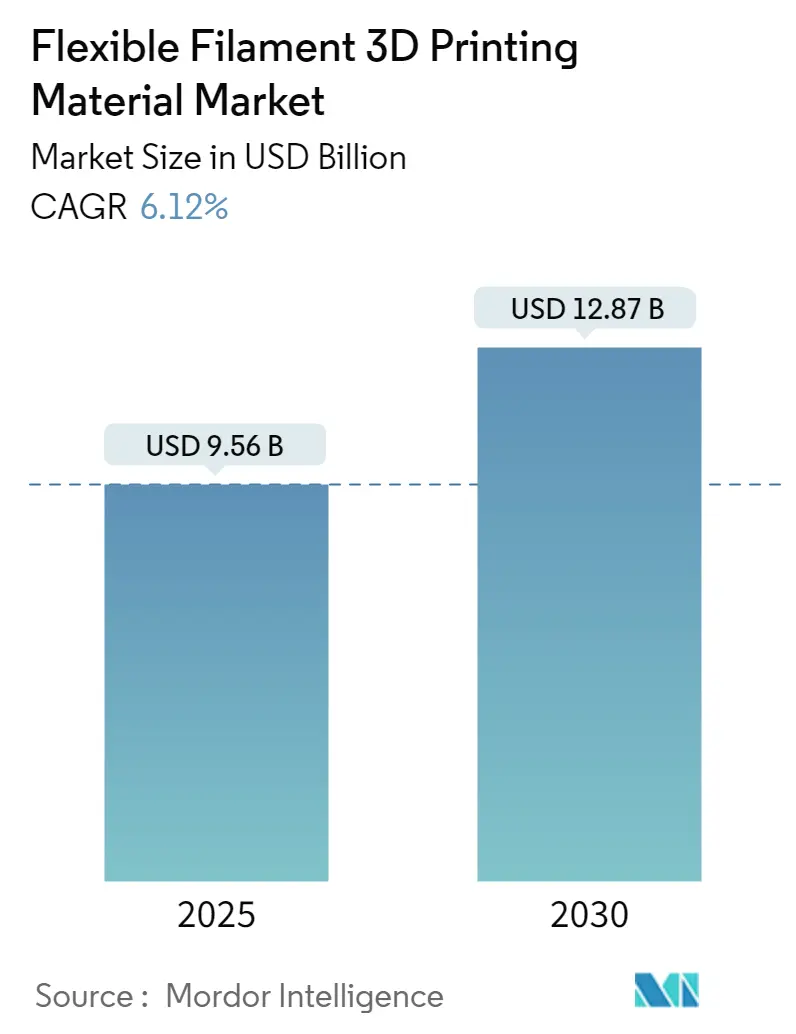
Flexible Filament 3D Printing Material Market Analysis by Mordor Intelligence
The Flexible Filament 3D Printing Material Market size is estimated at USD 9.56 billion in 2025, and is expected to reach USD 12.87 billion by 2030, at a CAGR of 6.12% during the forecast period (2025-2030).
- As the 3D printing industry rapidly evolves, the diversity and sophistication of printing materials are keeping pace with advancements in printers. Among these innovative materials, flexible resin, Thermoplastic Polyurethane (TPU), and other elastomeric filaments are ushering in a new era of possibilities in additive manufacturing.
- These materials are gaining traction owing to their inherent advantages. Utilizing flexible filaments such as elastomers and TPU in 3D printing bestows significant impact resistance, resulting in durable components that can withstand external forces while maintaining their structural integrity. This not only extends the lifespan and safety of the components but also minimizes the need for replacements or repairs. Such attributes are particularly prized in industries like automotive, aerospace, and sports equipment, where parts routinely encounter impacts and stresses.
- In addition to impact resistance, these materials boast resilience and durability, allowing components to endure mechanical stresses while retaining their shape and functionality. Such characteristics are invaluable in applications that demand frequent use and resistance to wear or environmental degradation.
- Key drivers propelling the market include heightened research and development across various industrial sectors, leading to a surge in the popularity of 3D prototyping and industry-specific product innovations. Designers leveraging elastic properties in their products can now test functionality with real-world flexibility. In product and industrial design, flexible filament materials facilitate testing a wide array of prototypes, from bike handles to intricate machine components.
- Moreover, the growing appetite for customized products and an emphasis on digital manufacturing in sectors like manufacturing, healthcare, automotive, and aerospace underscores the significance of flexible filament materials in 3D printing. A prime example is Adidas, the globally recognized sportswear giant. They harnessed 3D printing technology for their Futurecraft 4D shoes, allowing them to tailor the midsoles for individual wearers. Such a degree of customization was unattainable through conventional manufacturing. The swift market acceptance of the Futurecraft 4D shoes underscored the demand for personalized products. Building on this success, Adidas has expanded its lineup to include a range of mass-produced running shoes featuring lightweight 3D-printed insoles, all crafted using the Carbon3D system.
- Additionally, as industries embrace the evolution of Industry 4.0, there's a burgeoning demand for industrial robots, further amplifying the significance of the studied market on a global scale. However, challenges loom large. Rising material costs have cast a shadow over the flexible filament 3D printing material sector, creating hurdles in production and distribution. Manufacturers grapple with maintaining competitive pricing, a struggle intensified by soaring raw material procurement costs, ultimately stunting industry growth.
Global Flexible Filament 3D Printing Material Market Trends and Insights
Aerospace and Defense expected to Observe Significant Growth
- The aerospace and defence industry is poised for growth. With aircraft backlogs reaching peak levels, manufacturers are set to increase production rates, fueling this growth. In the defence sector, global tensions, geopolitical risks, a recovering U.S. defence budget, and increased spending by regional powers like China, India, and Japan are anticipated to bolster the global defence sector in the coming years.
- Airbus highlights a strong desire for travel among people. Over the next two decades, Airbus predicts traffic will more than double (x2.4). In the initial three years, traffic is expected to grow at ~8% annually, recovering from pandemic losses. Post-2027, growth is projected to stabilize at approximately 3.6% annually. Airbus forecasts a demand for over 42,000 new deliveries as newer aircraft (passenger aircraft with over 100 seats and freighters with over 10 tons’ payload) replace older, less fuel-efficient models.
- Consequently, the aerospace and defence industry is adopting advanced manufacturing processes, often referred to as Industry 4.0, digital manufacturing, or smart manufacturing. These encompass powerful creation technologies, including 3D manufacturing.
- At the heart of this technological shift are specialized materials, particularly 3D printing filaments. These materials, tailored for both commercial airliners and unmanned aerial vehicles (UAVs), are setting new benchmarks in aerospace and drone manufacturing, thanks to their lightweight, durability, and high performance.
- In November 2023, Markforged Holding Corporation unveiled 'Vega', a high-performance filament tailored for aerospace manufacturing, compatible with Markforged’s FX20 printer. Beyond its exceptional strength, Vega promises significant benefits in weight reduction, cost efficiency, and lead time savings. This innovative material broadens the scope of 3D printing with Continuous Fiber Reinforcement in aerospace, extending its application from aesthetic components to non-critical structural parts and similar uses.
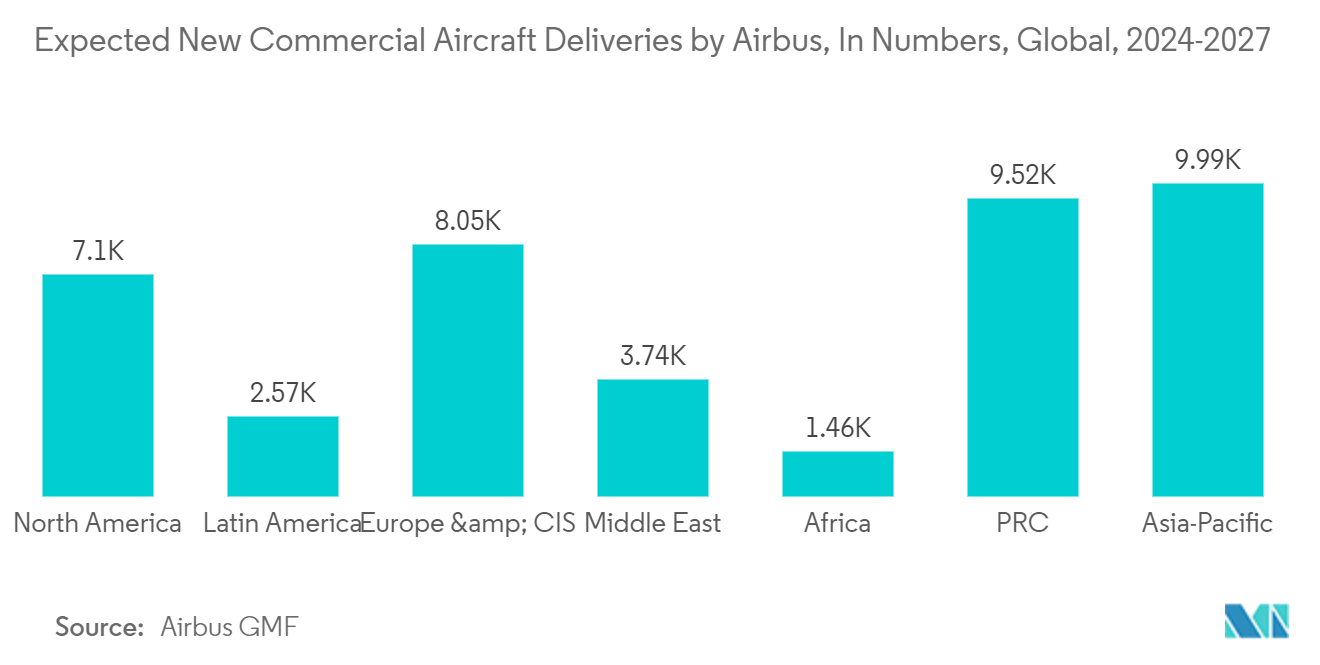
Asia Pacific Expected to Rise at a Significant Rate
- Across the Asia-Pacific, the rise of manufacturing facilities has spurred a heightened demand for flexible filament 3D printing materials. This surge is largely driven by rapid industrialization in developing nations, notably China and India. Initiatives such as India's 'Make in India' and China's 'Made In China 2025' highlight the governmental backing for strengthening domestic manufacturing.
- China's preeminence in the region's manufacturing arena is unmistakable. In 2023, China's industrial output neared 40 trillion yuan (approximately 5.57 trillion U.S. dollars), constituting 31.7% of its GDP. For 14 consecutive years, China's manufacturing prowess has led the global charts, a fact underscored by the Ministry of Industry and Information Technology (MIIT). Additionally, the 2023/24 Business Confidence Survey from the German Chambers of Commerce Abroad Greater China revealed that over half of the participating companies intend to boost their investments in China in the coming two years, citing the nation's robust supply chain and burgeoning innovation as key motivators.
- China's vast manufacturing landscape, influenced by geopolitical shifts, technological progress, and competitive advantages, is witnessing a notable evolution. With a clear pivot towards Industry 4.0, China's manufacturing sector is set for rapid expansion. As the world's leading manufacturing hub, China is at the forefront of the digital revolution, taking its extensive industrial base and technological expertise to spearhead innovation.
- In contrast, Japan's manufacturing artfully intertwines age-old traditions with state-of-the-art technology. The nation's unwavering commitment to innovation is underscored by its consistent top position in patent registrations. This innovative drive is further magnified by the integration of Industry 4.0 elements, like the Internet of Things (IoT) and AI, which are transforming traditional manufacturing paradigms, all bolstered by proactive government initiatives.
- As industrial sectors increasingly embrace automation, Asian manufacturing firms are turning to additive manufacturing, recognizing its potential to redefine traditional practices. 3D printing's advantages, such as swift prototyping and minimized material waste, empower manufacturers to craft intricate designs once deemed unattainable. Consequently, as 3D printing gains traction, flexible filament materials, notably elastomers and TPU, are becoming increasingly sought after for their pronounced utility.
- Flexible 3D printing stands out as a dynamic tool for crafting functional prototypes, enabling designers, engineers, and inventors to bring their visions to life. The elasticity offered by flexible 3D printing filaments facilitates the creation of objects with diverse rigidity levels. A key advantage of this technology in pipe and manifold production is its capability to produce intricate, organic shapes that enhance fluid flow by reducing pressure drops.
- Beyond that, it can design customized ergonomic handles and grips for a range of uses, from tools and sports gear to everyday consumer items. Its versatility extends to seals and gaskets, allowing for bespoke designs and intricate internal features like channels and lattice patterns.
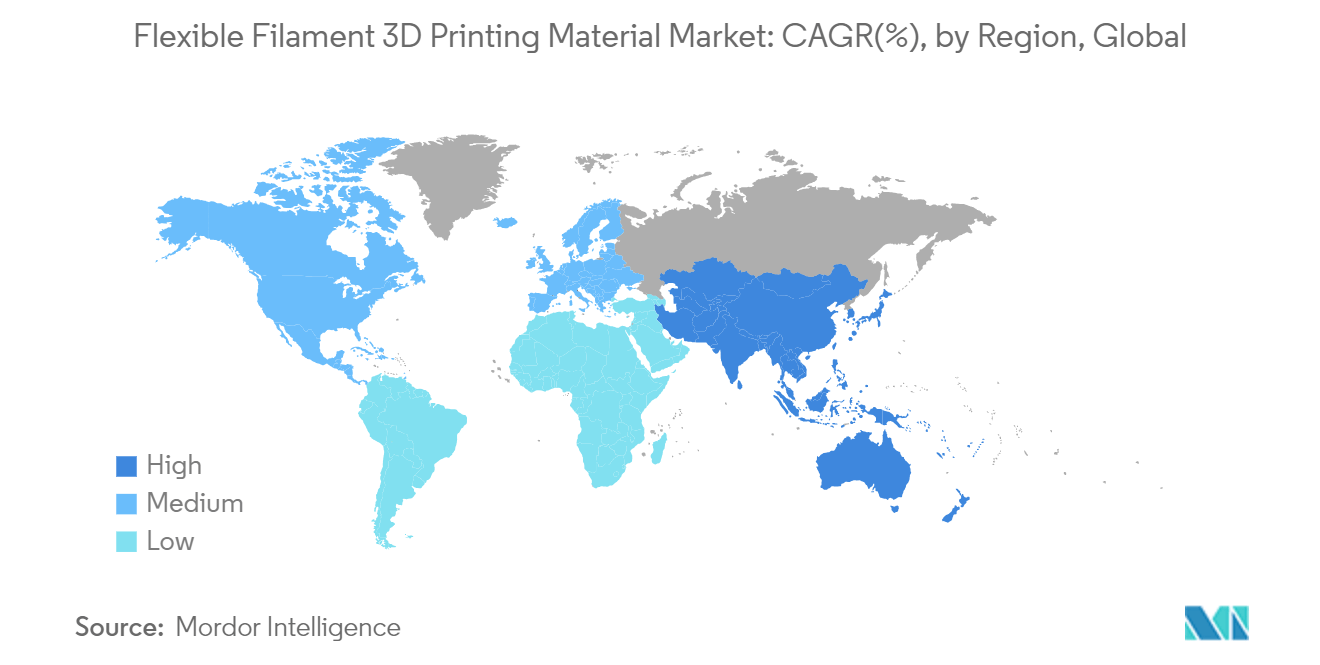
Competitive Landscape
The Flexible Filament 3D Printing Material market is characterized by a blend of global and regional players. Key players, including Höganäs AB, 3D Systems Corporation, Stratasys, Ltd., ExOne, and Formlabs are actively pursuing partnerships, mergers, acquisitions, and investments to strengthen their foothold in the market. These strategic manoeuvres are paving the way for expanded market opportunities.
The healthcare sector has rapidly embraced additive manufacturing, creating significant opportunities for the use of flexible filament 3D printing materials. As the population grows and chronic diseases become more prevalent, the increasing application of these materials in prosthetics, orthotics, and customized surgical devices is anticipated to drive substantial market traction.
Looking ahead, innovations in materials, particularly enhanced formulations of Thermoplastic Polyurethane (TPU), are set to deliver superior elasticity, durability, and abrasion resistance. These advancements are perfect for flexible filament components that demand both bendability and toughness. Additionally, the emergence of new conductive filaments materials will merge flexibility with electrical conductivity, opening doors to groundbreaking developments in wearable electronics and soft robotics.
Flexible Filament 3D Printing Material Industry Leaders
-
Höganäs AB
-
3D Systems Corporation
-
Stratasys, Ltd.
-
ExOne
-
Protolabs
- *Disclaimer: Major Players sorted in no particular order
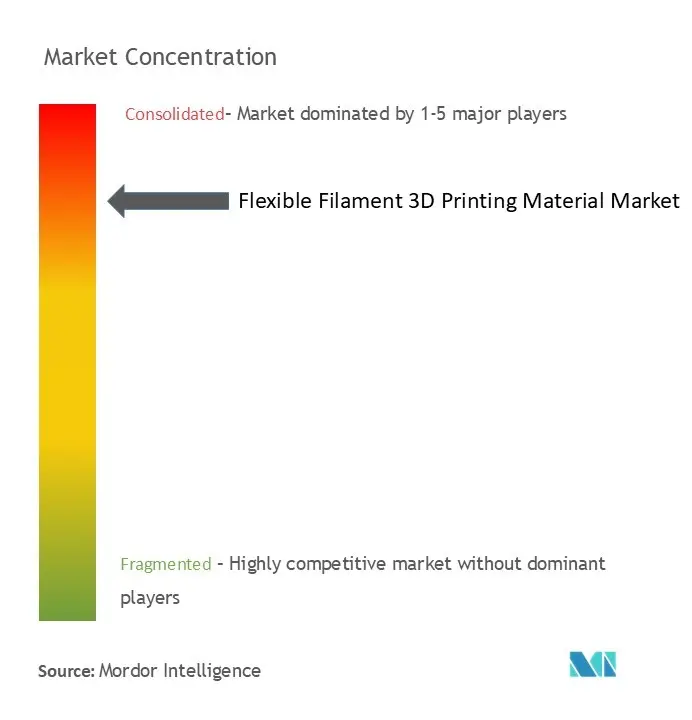
Recent Industry Developments
- July 2024: Bambu Lab has launched its latest 3D printing material, the high-speed PETG HF filament, with "HF" denoting "High Flow." Aimed at both hobbyists and professionals, this filament boosts printing speeds without compromising on quality. Now available, the PETG HF filament is set to enhance performance across various applications, especially those demanding strength and durability.
- October 2023: Evonik unveiled a new carbon-fiber reinforced PEEK filament, tailored for 3D printed medical implants. This innovative biomaterial is compatible with standard extrusion-based 3D printing methods, including fused filament fabrication (FFF). The specialty chemicals giant plans to showcase this cutting-edge product at upcoming medical technology and 3D printing trade shows.
Global Flexible Filament 3D Printing Material Market Report Scope
Flexible filament 3D printing materials are utilized in additive manufacturing to produce three-dimensional objects. Typically crafted from thermoplastic polymers like ABS, PLA, and PETG, these filaments can also include specialized materials such as nylon and carbon fiber.
The study tracks the revenue accrued through the sale of Flexible filament 3D printing materials by various players worldwide. The study also tracks the key market parameters, underlying growth influencers, and major vendors operating in the industry, which supports the market estimations and growth rates over the forecast period. The study further analyses the overall impact of COVID-19 aftereffects and other macroeconomic factors on the market. The report’s scope encompasses market sizing and forecasts for the various market segments
The flexible filament 3d printing material market is segmented by application (automotive, consumer goods, healthcare, aerospace and defence, and others) and region (North America, Europe, Asia Pacific, Latin America, Middle East, and Africa). The market size and forecasts are provided in terms of value (USD) for all the above segments.
| Automotive |
| Consumer Goods |
| Healthcare |
| Aerospace and Defense |
| Others |
| North America |
| Europe |
| Asia |
| Australia and New Zealand |
| Latin America |
| Middle East and Africa |
| By Application | Automotive |
| Consumer Goods | |
| Healthcare | |
| Aerospace and Defense | |
| Others | |
| By Geography | North America |
| Europe | |
| Asia | |
| Australia and New Zealand | |
| Latin America | |
| Middle East and Africa |
Key Questions Answered in the Report
How big is the Flexible Filament 3D Printing Material Market?
The Flexible Filament 3D Printing Material Market size is expected to reach USD 9.56 billion in 2025 and grow at a CAGR of 6.12% to reach USD 12.87 billion by 2030.
What is the current Flexible Filament 3D Printing Material Market size?
In 2025, the Flexible Filament 3D Printing Material Market size is expected to reach USD 9.56 billion.
Who are the key players in Flexible Filament 3D Printing Material Market?
Höganäs AB, 3D Systems Corporation, Stratasys, Ltd., ExOne and Protolabs are the major companies operating in the Flexible Filament 3D Printing Material Market.
Which is the fastest growing region in Flexible Filament 3D Printing Material Market?
Asia Pacific is estimated to grow at the highest CAGR over the forecast period (2025-2030).
Which region has the biggest share in Flexible Filament 3D Printing Material Market?
In 2025, the Asia Pacific accounts for the largest market share in Flexible Filament 3D Printing Material Market.
What years does this Flexible Filament 3D Printing Material Market cover, and what was the market size in 2024?
In 2024, the Flexible Filament 3D Printing Material Market size was estimated at USD 8.97 billion. The report covers the Flexible Filament 3D Printing Material Market historical market size for years: 2019, 2020, 2021, 2022, 2023 and 2024. The report also forecasts the Flexible Filament 3D Printing Material Market size for years: 2025, 2026, 2027, 2028, 2029 and 2030.
Page last updated on:
Flexible Filament 3D Printing Material Market Report
Statistics for the 2025 Flexible Filament 3D Printing Material market share, size and revenue growth rate, created by Mordor Intelligence™ Industry Reports. Flexible Filament 3D Printing Material analysis includes a market forecast outlook for 2025 to 2030 and historical overview. Get a sample of this industry analysis as a free report PDF download.
